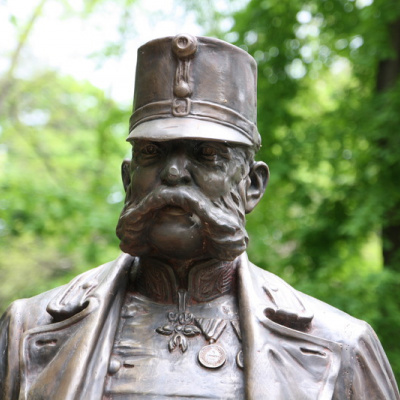Monument to Franz Joseph, Chernivtsi
The monument to the Austrian Emperor and King of Hungary Franz Joseph I, during whose reign Chernivtsi experienced a flourishing economy, was unveiled on October 3, 2009, and the first stone for the future monument was laid in 2008 during the celebration of Chernivtsi's 600th anniversary. The monument was made and installed at the expense of Arseniy Yatsenyuk, a native of Chernivtsi. The unveiling ceremony was also attended by Mayor of Chernivtsi M. T. Fedoruk, representatives of the regional authorities, Ambassador Extraordinary and Plenipotentiary of Austria to Ukraine Josef-Marcus Vuketich, and the general public. The authors of the monument are sculptor Volodymyr Tsisaryk and Honored Artist of Ukraine Serhiy Ivanov.
Arseniy Yatsenyuk emphasized that the unveiling of the monument to Emperor Franz Joseph I of Austria-Hungary was a restoration of historical justice. "There was a fair assessment of historical events in Bukovyna. After all, Ukraine and Bukovyna were part of the empire, and it was during the period of this empire that a very serious development took place here. Chernivtsi began to develop as a national cultural center, starting with the opening of the university and ending with four Ukrainian-language schools, Ukrainian newspapers, and the overall economic, social, and political movement," he noted.
The city of Chernivtsi reached its peak when Bukovyna was part of the Austro-Hungarian Empire under Emperor Franz Joseph I (1848-1916). It is his name that is associated with the rapid economic and cultural development of the city, including the emergence of the Chernivtsi-Lviv railway, a power plant, the commissioning of an electric tram, water supply and sewage systems, the construction of a cathedral, a city theater, and schools, including four folk schools with Ukrainian as the language of instruction. In 1875, Chernivtsi University was founded.
Franz Joseph I - Ruler of the Austrian Empire and King of Bohemia from December 2, 1848, Apostolic King of Hungary (December 2, 1848 - April 14, 1849; from August 13, 1849); King of Galicia and Volodymyr; Grand Duke of Bukovyna; from March 15, 1867 - Head of the two-state Austro-Hungarian monarchy.
During the reign of Emperor Franz Joseph (1848-1916), Bukovyna was part of the Austro-Hungarian Empire. It was at that time that Chernivtsi reached its heyday. The city experienced a significant economic boom, which led to a construction boom and the creation of architectural monuments that still amaze with their grandeur. At the same time, Chernivtsi became a cultural and educational national center: a university was opened here, a huge public library was created, and schools were opened where Ukrainian was taught. Thanks to the active work of Ukrainian societies, the first newspapers were published.
Chernivtsi is the capital of Bukovyna. It is one of the most beautiful and pleasant Ukrainian cities. There is one of the most beautifulrailway stations in the country, theChurch of St. Paraskeva of Serbia, the Church of the Exaltation of the Cross, the ship house, the City Hall (every day at 12:00 a trumpeter plays the melody of "Marichka" from the tower), the Art Museum, then Kobylianska Street, the German Folk House, the Armenian Church and the Assumption Church (the oldest stone Ukrainian Greek Catholic Church in Chernivtsi), the Theater Square and the Kobylianska Theater. Kobylianska Theater Square, Jewish People's House, Chernivtsi University (included in the UNESCO World Heritage List), Turkish Square (Chernivtsi has been a part of Turkey, Modova, Romania, Austria-Hungary, the USSR, Rus, and Ukraine), and a large rover,cozy streets and cobblestones, the so-called Drunken Church, Nazariy Yaremchuk's house, then another house-ship, two houses with the same number (Olha Kobylianska lived here), the house where Volodymyr Ivasyuk lived, the pink church - the Cathedral of the Holy Spirit.
Chernivtsi sights
- St. Nicholas wooden church (from 1607, restored in 1954);
- Stone Church of St. George on the Bitterroot (1767 in the Baroque style);
- the wooden Trinity Church in Muggles (one thousand seven hundred and seventy-four), moved in 1874 to Kłokuchka;
- wooden Assumption Church on Kaleczanka (1783);
- City Hall with a two-story, 45-meter-high Empire-style tower (1843-1847, architect A. Mykulych), now the City Council;
- Ukrainian Greek Catholic Church (1825-1830 in the Baroque style);
- Byzantine-style cathedral (1844-1864, architect Roll);
- Church of St. Paraskeva in the pseudo-Romanesque style, completed in 1662 (architect A. Pavlovsky);
- residence of Bukovyna metropolitans - since 1956 one of the buildings of Chernivtsi University);
- Armenian Gregorian Church (1869-1875, architect J. Hlavka);
- Chernivtsi University building (1874-1875);
- Jesuit church in the Neo-Gothic style (1893-1894);
- Railway station (1898-1903) in the Art Nouveau style;
- the City Theater (1904-1905, architects F. Fellner and G. Helmer) in the Viennese Baroque style with Art Nouveau elements (now the O. Kobylianska Music and Drama Theater), etc.






